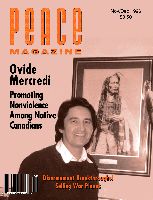
Peace Magazine Nov-Dec 1996, page 20. Some rights reserved.
Search for other articles by Doris Jean Dyke here
K. Louise Schmidt. Philadelphia: New Society, 1995. 154 Pp.
In this book, author Louise Schmidt combines feminism and nonviolence by proposing a nonviolent response to the sexual abuse of women and children. Her approach is aimed, at the same time, at breaking the cycle of male violence that is passed on from one generation to another.
The book looks at the connection between feminism and nonviolence in the individual and in society. Without feminist analysis, says Schmidt, we do not recognize that violence against women, children, and the earth are acts of tyranny. Without nonviolence training, anger can turn toward revenge and hatred, particularly self-hatred, rather than toward healing, peace, and dignity.
Throughout the book, the margins are filled with quotations. The authors of the quotations are acknowledged, and the sources are cited after each chapter. Since there are quotations on almost every page over 200 endnotes referring to them, the overall effect is almost a reference book of quotations. I found the busyness of the format distracting, but it's interesting to have quotations from Helen Keller, Simone de Beauvoir, Alice Walker, Virginia Woolf, Gloria Steinem, Martin Luther King, Jr. and many others who have said memorable things about peace, oppression, suffering, or feminism.
Part One, "Our Lives," provides an overview of human rights violations against women and children. Sexual and physical abuse against women is connected to warfare and terrorism. A quotation from the War Resisters League says, "The mentality that builds nuclear weapons is the same one that rapes women and destroys the environment."
An important section on pornography is found in the opening chapter, where Schmidt asserts:
The link between pornography, militarism and rape is most obvious where we consider the dehumanization that is necessary before asserting the "right" to exploit or violate another …. For systemized rape to be finally recognized as a war crime and included in post-war indictments of documented forms of torture, the turning of rape into pornography will also have to be recognized.
The second section, "Our Work," accounts for over half of the book. In these chapters we find an account of the work being done to end male violence. Among the tasks identified are the need for education and self-defence, the battered women's movement, and the need to break the silence, tell stories, and create safety zones. As well there is an analysis of nonviolence in both our families and in our communities. This section is both descriptive and prescriptive.
In the last section, "Our Future," Schmidt argues that the value of community lies in the value of each individual finding his/her place in the community, enabling each to contribute and receive. Schmidt points out that our repulsion toward violence may prevent us from being responsive to both victim and offender. She says that excluding, disbelieving, persecuting, and misunderstanding continue the hate that violent behavior requires. The last chapter of this section, entitled "Grace," uses traditional religious language such as transformation, ceremony, celebration, gratitude, sacrament, forgiveness, love, joy, and wholeness. These words are not used in any superficial way. Forgiveness and healing can occur only when an abuser accepts responsibility, stops the abuse, and asks what form of retribution is needed. Genuine forgiveness takes place after healing has begun and dynamic nonviolence is pursued.
I found the exercises at the end of the book the most original contribution made by the author. One of Schmidt's "truth and testimony" exercises, for example, instructs the participants as follows:
In dyads, share an experience of violence in which you were 1) the victim, 2) the violator, and 3) a witness. Each person takes a turn, beginning with the victim and each ends with a story of being a witness. Take time with each story.
The exercises, in which politics, spirituality, and psychotherapy are simultaneously presented, can be used by individuals and small or large groups and there is ample room for creativity and variety in their use.
Reviewed by Doris Jean Dyke, professor emerita of Emmanuel College at the University of Toronto.

Peace Magazine Nov-Dec 1996, page 20. Some rights reserved.
Search for other articles by Doris Jean Dyke here